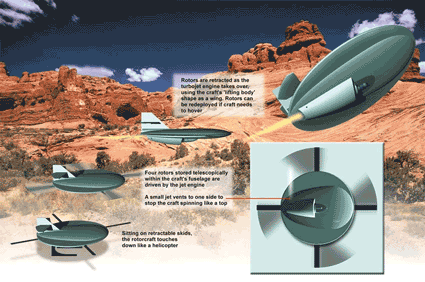
cartome.org
20 March 2002

Disc-shaped spyplane
could hunt for terrorists
New Scientist
12:25 04 February
02
by Max Glaskin
SiMiCon Rotor Craft (SRC)
What looks like a flying saucer, takes off like a helicopter and flies like
a plane? The next remote-controlled surveillance aircraft on the hunt for terrorist
fugitives like Osama bin Laden, apparently.
Pilotless aircraft came into their own in the Afghan conflict, greatly reducing casualties in US Air Force and ground troops on both reconnaissance and attack missions. But today's uninhabited aerial vehicles, or UAVs, have big drawbacks: they need a runway, they are slow and they cannot hover. But a bizarre machine that aims to fix all these problems passed its first wind tunnel tests last week at Norway's National University for Technology and Science in Trondheim.
The disc-shaped SiMiCon Rotor Craft (SRC) appears to be inspired at least partly by the design of Star Trek's USS Enterprise, but instead of twin engines raised above the main body it has a single rear jet engine below it--and a conventional tailplane above.
It's also tiny. A full-size machine will have a diameter of just 4.5 metres, though development work and testing is being done with three scale models, each with a diameter of 1.5 metres.
Conventional runways
The circular fuselage is shaped like an aerofoil and contains retractable rotor blades that extend telescopically from the disc as they spin up to speed. These are driven by a small jet engine and allow vertical take-off. When the craft has taken off, the jet engine, which is fixed below, takes over to propel it forward. The rotor blades then retract into the circular wing, but can be extended again when the craft needs to hover or land. To prevent the craft from spinning like a top, sideways thrust from the jet engine, or a small tail rotor, counters the effect of rotor torque.
The SRC's three-man design team hopes military and civilian organisations will be interested. "The UAV market is more accepting of unusual designs than the manned aircraft industry," says Ragnvald Otterlei of Trondheim-based SiMiCon. With no people on board, safety is a low priority.
More than 150 UAV designs have emerged in recent years, but few have combined vertical take-off with high-speed forward flight and the ability to hover. Both types of UAV that the Americans used in Afghanistan need conventional runways. The Predator from General Atomics needs a 670-metre take-off strip, while the high-altitude Global Hawk from Northrop Grumman needs more than a kilometre to get airborne. The SRC, however, should be able to take off from the back of a flatbed truck.
Civilian applications
The wind tunnel tests proved the SRC would be stable at low and high rotor speeds and during the transition from vertical flight to forward flight, says SiMiCon designer Vegard Evjen Hovstein. "The next challenge is to find a low-profile jet engine design which doesn't project too far below the aircraft's bottom disc," he says.
The project is brimming with unknowns: how will the extension and retraction of the rotor blades work? And can the rotor be angled to change the craft's direction?
"What we have done so far is build models with off-the-shelf components from radio-controlled kits and shown that our ideas are robust enough to work even with such poor materials," says Hovstein.
He's bullish about potential
civilian applications for his versatile UAV. The vehicle could be used by police
for surveillance, or to track pollution and map terrain, he says. But he adds
that it could be five years before the first SRC takes to the air.
12:25 04 February 02
© Copyright
Reed Business Information Ltd.